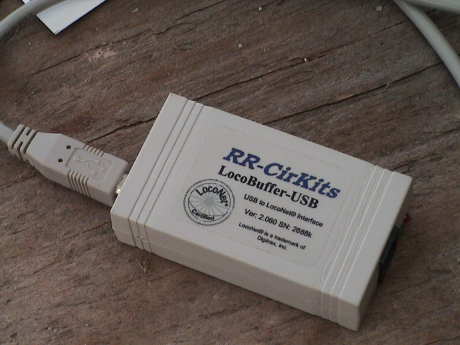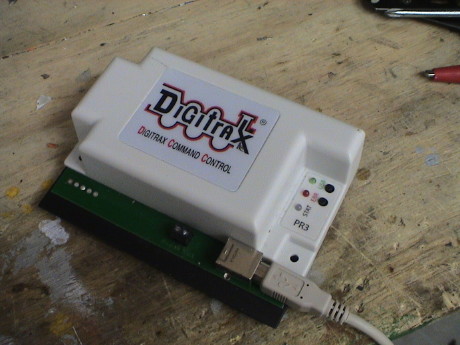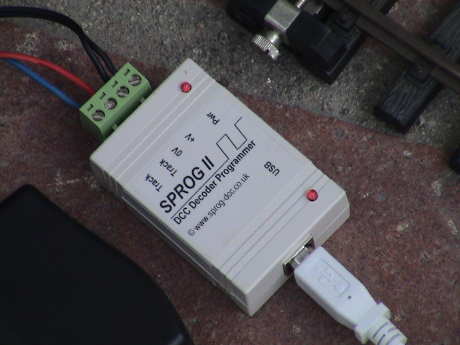 7 Apr 12
7 Apr 12[ Home ] [ Up ] [ Previous Page ] [ Next Page ]
A cottage industry of sorts has sprung up to supply interfaces between computers and DCC systems. Older ones used a serial interface and a COM port on a PC. The newer ones usually use a USB interface. On a PC, it is still a COM port. On a Mac, it is just sort of there but they all need some sort of supplied driver installed.
These devices are distinct from the "sound programmers" supplied by most of the major sound system manufacturers for their proprietary hardware. Phoenix, QSI, Soundtraxx and ESU supply interfaces and PC only software to allow the sound program in a system to be replaced or modified. The Digitrax PR3 can be used to program Digitrax sound decoders and ordinary DCC decoders. It can also act as a computer interface to a layout.
On the computer side, there are several version of commercial and open source software that allow some sort of interaction with a DCC layout. I use the open source JMRI software for the three interfaces described below. JMRI runs on the Mac OS, Windows and Linux.
Each of the three interfaces described below really has a different purpose but there is some functional overlap between them. The Locobuffer-USB is a straight interface between JMRI (and others) and the Digitrax LocoNet, it is only useful with the Digitrax network. The Digitrax PR3 also provides the same interface capability as the LocoBuffer-USB, but it can also program Digitrax sound decoders via JMRI or Digitrax's SoundLoader software. It can also act as a standalone DCC decoder programmer using JMRI. The SPROG is a standalone DCC decoder programmer (using JMRI again) or it can act as a basic, low power, DCC command station using JMRI as the user interface.
Where a device can perform multiple functions, it can only do ONE AT A TIME and it may require some wiring changes as well to change modes.
| Device | Street Price | LocoNet Interface | Stand Alone DCC Decoder Programmer |
Sound Programmer | Stand Alone Command Station |
Power Supply | Notes |
|---|---|---|---|---|---|---|---|
| LocoBuffer-USB | $55 | 
|
Self powered, no power supply needed | Easiest to set up | |||
| PR3 | $60 | 
|

Does not work with a Soundtraxx Tsunami with the recommended 14 volt power supply. |
 Digitrax only via JMRI or SoundLoader |
Needs a 14 volt 300 mA power supply to act as a programmer, no power supply needed as an interface |
Separate connections for the LocoNet and Programming track interface. Soundloader software is PC only. |
|
| SPROG II | $100 |  higher programming track power for CV programming of difficult to program sound decoders |

|
Needs a 12 volt 1+ amp power supply |
To switch between programming and command station mode, it needs to be wired to the appropriate track. This can be done with a switch. |
 The LocoBuffer-USB is a pretty simple
device, it does only one thing but does it well. It provides and
interface between a computer running JMRI (and perhaps other software)
and the Digitrax LocoNet. JMRI then works through the LocoNet and a
Digitrax command station to do anything that can be done on a DT400
throttle. Even without a Digitrax command station, the LocoBuffer can
interface to Digitrax stationary decoders, such as the DS64, to allow
the PanelPro application in JMRI to control turnouts.
The LocoBuffer-USB is a pretty simple
device, it does only one thing but does it well. It provides and
interface between a computer running JMRI (and perhaps other software)
and the Digitrax LocoNet. JMRI then works through the LocoNet and a
Digitrax command station to do anything that can be done on a DT400
throttle. Even without a Digitrax command station, the LocoBuffer can
interface to Digitrax stationary decoders, such as the DS64, to allow
the PanelPro application in JMRI to control turnouts.
The LocoBuffer is powered from both the USB side and the LocoNet side and is optically isolated in between so that ground loops that MIGHT exist between a computer and the LocoNet are prevented from even possibly causing a problem.
While decoder programming can be done reasonably well on a DT400 throttle, the harder to program parts, like 28 step speed tables and function remapping, are much easier to do in JMRI. JMRI can also read the entire contents of a decoder (provided that the command station can readback CV values, some can't) and store it on the computer. If later you want to know how a decoder was set up, you can use JMRI to look up the CV values that existed when the decoder was examined. If you have read and recorded a decoder state in DecoderPro, you can fully restore the decoder to that same state at a later time.
JMRI can also set up the OPSW settings of a command station or DS64 MUCH more easily that using a throttle.
Installation of the LocoBuffer II on a computer is easy. Both the Mac and PC require a driver. There are apparently at least TWO versions of the interface chip in the LocoBuffer so that you need to be sure to use the version of the driver that comes with it.
 The
Digitrax PR3 can
do the same interfacing job that the LocoBuffer-USB can do but at a
slightly higher cost and without the optical isolation. As an
interface, it is powered from the USB side. As a programmer, it
requires an external power supply.
The
Digitrax PR3 can
do the same interfacing job that the LocoBuffer-USB can do but at a
slightly higher cost and without the optical isolation. As an
interface, it is powered from the USB side. As a programmer, it
requires an external power supply.
The PR3 can also drive a programming track. For DCC users with basic systems that do not have the physical ability to read back from the programming track (Digitrax Empire Builder is one), the PR3 can provide that functionality using JMRI as the user interface. In my experience, the PR3 does not have enough power on it's dedicated programming track to program finicky sound decoders such as the Soundtraxx Tsunami. Some folks claim that it will work with a Tsunami if you provide it 18 volts DC but it is not rated to work at 18 volts.
For users of Digitrax DCC systems with a full up programming track capability, the PR3 allows programming on the command station's programming track OR on it's own programming track.
Further, the PR3 allows Digitrax sound decoders to have their sound projects changed out or modified. Replacing entire sound projects or individual sound files can be done in either JMRI (note possible bugs in JMRI may prevent it from successfully downloading a sound file in some configurations) or Digitrax's SoundLoader software (supplied with the PR3). Doing anything more extensive, such as changing the logic of a sound project, is much more involved and beyond the scope of this page.
I use SoundLoader running in Windows 7 which in turn is virtualized in Parallels so that the whole works runs on a Mac running Snow Leopard, Lion or Mountain Lion. Parallels version 5 will run on Snow Leopard, version 6 is required for Lion and Parallels 7 or 8 is required for Mountain Lion. In any event, the Mac should have 4 GB or preferably more RAM to run Windows 7 in Parallels. The installation in on a physical or virtualized PC is the same, you have to manually install a driver to allow Soundloader to access the PR3 via a USB port.
Driver installation on a Mac is not required, the VCOM drivers are built in. In JMRI you do have to select the right serial port in JMRI preferences and it is sometimes not obvious which one that is. It is one of the usbmodem options but it has been different for me depending on which system I do the install.
 The SPROG is sort of an odd
beast. It does NOT provide an interface between JMRI and a command station, but
it DOES allow programming of some recalcitrant decoders. Some sound
decoders will not accept programming on a regular programming track,
hence the market for "programming track boosters" which add a little
"oomph" to allow some decoders, particularly Soundtraxx ones, to be
programmed. Most sound decoders can be programmed in OPS mode but some
will not allow an address to be reprogrammed in OPS mode (to prevent
programming accidents). Without a SPROG or a booster, it is sometimes
hard to change their addresses.
The SPROG is sort of an odd
beast. It does NOT provide an interface between JMRI and a command station, but
it DOES allow programming of some recalcitrant decoders. Some sound
decoders will not accept programming on a regular programming track,
hence the market for "programming track boosters" which add a little
"oomph" to allow some decoders, particularly Soundtraxx ones, to be
programmed. Most sound decoders can be programmed in OPS mode but some
will not allow an address to be reprogrammed in OPS mode (to prevent
programming accidents). Without a SPROG or a booster, it is sometimes
hard to change their addresses.
The SPROG will also act as a low power command station (11 volts on the track, 996 mA max load current) using JMRI for the throttles. As a command station it is pretty basic and would be suitable for most small Z or N scale layouts. The low output voltage may be suitable for some HO layouts with newer locomotives that don't need a lot of track voltage. However, the GIRR HO layout is not one of those, it needs 16 volts to allow some engines to run right.
As a command station, the SPROG is pretty basic but it allows most of the useful things to be done. It can handle 10 locos at a time but not all of them can be actually running at one time or the SPROG will go overcurrent and shutdown. I have been able to run one single motor large scale loco with the SPROG, but not at full speed and not with any sort of a load.
The SPROG outputs much more programming power than most programmers. This is why it works with even the most difficult decoders. However, there are a couple of downsides to higher programming power.
First, there is enough power to actually cause some locos to bump along the track, especially when reading back the decoder contents of a lot of CVs such as what happens when the entire contents of a decoder is read back. Each time that the decoder responds, it draws a pulse of current in the motor to signal the command station. The SPROG's pulse is larger and can actually drive the motor. Be careful that your loco doesn't drive itself off the programming track.
Second, most command stations limit the power that they can provide to a programming track to reduce the stresses placed on an improperly wired decoder. It is a very good idea to put a loco with a newly installed decoder on a programming track FIRST. Try to read back some address, such as the default two digit address of most decoders, 03. If the decoder responds properly, it is highly likely that there isn't a wiring problem with the new installation. The limited power is less likely to damage a decoder in a miswired condition. The SPROG puts out much more power and there might be some instances of incorrect wiring and weaker decoders that would allow the SPROG to blow up a miswired decoder. I have never seen this happen, but it is more likely to happen with the SPROG driving a programming track than a weaker command station. It might be a good idea to pretest a new installation on a regular programming track first. You can simulate a weaker programming track by putting a 30 to 40Ω resistor in series with the SPROG's programming track and then shorting the resistor out once you know that the decoder installation is good.
The SPROG needs an external power supply to operate in any mode. I used the one that is sold with it, but any 12 volt power supply capable of an amp or better should work. Whatever you use, it needs to be well regulated, pure DC. Typical train set power packs won't do.
I have had some difficulty with the SPROG USB drivers on a Macintosh with older versions of JMRI (less than version 12). The drivers usually work but sometimes the SPROG seems to get locked up and communication between the computer and SPROG seems to die. Newer versions of JMRI (2.14 and later) have the drivers built in.
The folks that make the SPROG saw this (April 2012) and they have provided some comments.
"SPROG IIv3 is a newer edition of the SPROG II that you have, with a new chip internally. So what? It installs much more easily on a Mac! The USB driver in this is a standard driver, and so there is no driver install; less odd behavior, etc. Otherwise, exactly the same features as the current version."
"SPROG3 might be interesting to you and your HO railroad. SPROG3 comes (today) with a 14V 3A supply, and can offer 2.5A to the track. It can also run from well-regulated power supplies up to 20V and we will offer an 18V supply in the near future. Same easy-install on Mac - no driver needed."
[ Home ] [ Up ] [ Previous Page ] [ Next Page ]
This page has been accessed times since 27 May 09.
© 2008-2012 George Schreyer
Created 27 May 09
Last Updated October 24, 2012